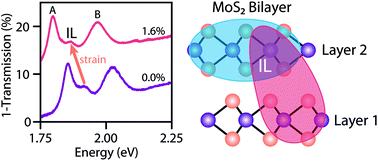Interlayer excitons in bilayer MoS2 under uniaxial tensile strain†
Abstract
Atomically thin semiconducting transition metal dichalcogenides (TMDCs) have unique mechanical and optical properties. They are extremely flexible and exhibit a strong optical absorption at their excitonic resonances. Excitons in TMDC monolayers are strongly influenced by mechanical strain. Their energy shifts and even their line widths change. In bilayers, intralayer excitons with electrons and holes residing in the same layer also shift their energy with the applied strain. Recently, interlayer excitons with electrons and holes in different layers have been observed in bilayer MoS2 at room temperature. Here, we report on the behavior of interlayer excitons in bilayer MoS2 under uniaxial tensile strain of up to 1.6%. By recording the differential transmission spectra for different strain values, we derive a gauge factor of −47 meV per % for the energy shift of the interlayer exciton, which is similar to −49 meV per % for the intralayer A and B excitons. Our finding confirms the origin of the interlayer exciton at the K point in the Brillouin zone, with the electron located in one layer and the hole delocalized over two layers. Furthermore, our work paves the way for future straintronic devices based on interlayer excitons.



 Please wait while we load your content...
Please wait while we load your content...